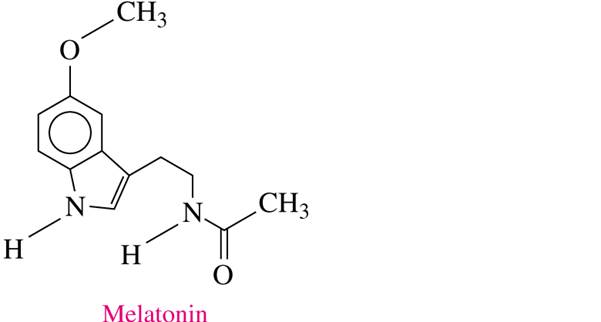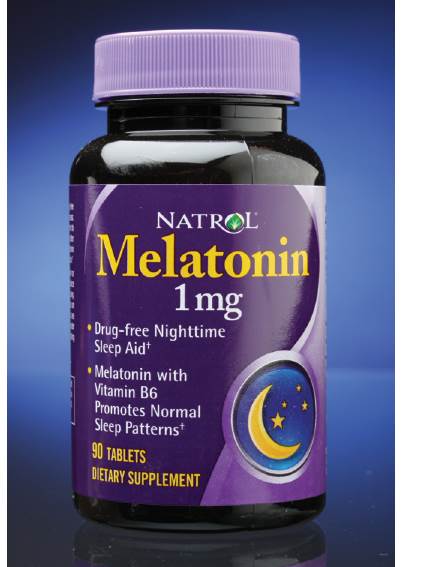
General, Organic, and Biological Chemistry: Structures of Life (5th Edition)
5th Edition
ISBN: 9780321967466
Author: Karen C. Timberlake
Publisher: PEARSON
expand_more
expand_more
format_list_bulleted
Concept explainers
Textbook Question
Chapter 18, Problem 18.64UTC
Melatonin is a naturally occurring compound n plants and animals, where it regulates the biologicaltime clock Melatonin is sometimes used to counteract jet lag.Identify the


Expert Solution & Answer
Want to see the full answer?
Check out a sample textbook solution
Students have asked these similar questions
Strain Energy for Alkanes
Interaction / Compound kJ/mol kcal/mol
H: H eclipsing
4.0
1.0
H: CH3 eclipsing
5.8
1.4
CH3 CH3 eclipsing
11.0
2.6
gauche butane
3.8
0.9
cyclopropane
115
27.5
cyclobutane
110
26.3
cyclopentane
26.0
6.2
cycloheptane
26.2
6.3
cyclooctane
40.5
9.7
(Calculate your answer to the nearest 0.1 energy unit, and be sure to specify units, kJ/mol or kcal/mol. The answer is case
sensitive.)
H.
H
Previous
Next
A certain half-reaction has a standard reduction potential Ered +1.26 V. An engineer proposes using this half-reaction at the anode of a galvanic cell that
must provide at least 1.10 V of electrical power. The cell will operate under standard conditions.
Note for advanced students: assume the engineer requires this half-reaction to happen at the anode of the cell.
Is there a minimum standard reduction
potential that the half-reaction used at
the cathode of this cell can have?
If so, check the "yes" box and calculate
the minimum. Round your answer to 2
decimal places. If there is no lower
limit, check the "no" box..
Is there a maximum standard reduction
potential that the half-reaction used at
the cathode of this cell can have?
If so, check the "yes" box and calculate
the maximum. Round your answer to 2
decimal places. If there is no upper
limit, check the "no" box.
yes, there is a minimum.
1
red
Πν
no minimum
Oyes, there is a maximum.
0
E
red
Dv
By using the information in the ALEKS…
In statistical thermodynamics, check the
hcv
following equality: ß Aɛ =
KT
Chapter 18 Solutions
General, Organic, and Biological Chemistry: Structures of Life (5th Edition)
Ch. 18.1 - Prob. 18.1QAPCh. 18.1 - Prob. 18.2QAPCh. 18.1 - Prob. 18.3QAPCh. 18.1 - Prob. 18.4QAPCh. 18.1 - Prob. 18.5QAPCh. 18.1 - Prob. 18.6QAPCh. 18.1 - Prob. 18.7QAPCh. 18.1 - Prob. 18.8QAPCh. 18.1 - Prob. 18.9QAPCh. 18.1 - Prob. 18.10QAP
Ch. 18.2 - Prob. 18.11QAPCh. 18.2 - Prob. 18.12QAPCh. 18.2 - Prob. 18.13QAPCh. 18.2 - Assign the boiling point of 3 C, 48 C, or 97 C to...Ch. 18.2 - Prob. 18.15QAPCh. 18.2 - Prob. 18.16QAPCh. 18.2 - Prob. 18.17QAPCh. 18.2 - Prob. 18.18QAPCh. 18.2 - Prob. 18.19QAPCh. 18.2 - Prob. 18.20QAPCh. 18.2 - Prob. 18.21QAPCh. 18.2 - Prob. 18.22QAPCh. 18.3 - Prob. 18.23QAPCh. 18.3 - Prob. 18.24QAPCh. 18.3 - Prob. 18.25QAPCh. 18.3 - Prob. 18.26QAPCh. 18.3 - Prob. 18.27QAPCh. 18.3 - Prob. 18.28QAPCh. 18.4 - Prob. 18.29QAPCh. 18.4 - Prob. 18.30QAPCh. 18.4 - When is a neurotransmitter released into the...Ch. 18.4 - Prob. 18.32QAPCh. 18.4 - Why is it important to remove a neurotransmitter...Ch. 18.4 - Prob. 18.34QAPCh. 18.4 - Prob. 18.35QAPCh. 18.4 - Prob. 18.36QAPCh. 18.4 - Prob. 18.37QAPCh. 18.4 - Prob. 18.38QAPCh. 18.4 - Prob. 18.39QAPCh. 18.4 - Prob. 18.40QAPCh. 18.4 - Prob. 18.41QAPCh. 18.4 - Prob. 18.42QAPCh. 18.4 - Prob. 18.43QAPCh. 18.4 - What happens if there is an excess of glutamate in...Ch. 18.4 - Prob. 18.45QAPCh. 18.4 - Prob. 18.46QAPCh. 18.5 - Prob. 18.47QAPCh. 18.5 - Prob. 18.48QAPCh. 18.5 - Prob. 18.49QAPCh. 18.5 - Prob. 18.50QAPCh. 18.5 - Prob. 18.51QAPCh. 18.5 - Prob. 18.52QAPCh. 18.5 - Prob. 18.53QAPCh. 18.5 - Prob. 18.54QAPCh. 18.6 - Prob. 18.55QAPCh. 18.6 - Prob. 18.56QAPCh. 18.6 - Prob. 18.57QAPCh. 18.6 - Name the functional groups in enrofloxacin.Ch. 18.6 - Prob. 18.59QAPCh. 18.6 - Prob. 18.60QAPCh. 18 - Prob. 18.61UTCCh. 18 - 18.62 Some aspirin substitutes contain phenacetin...Ch. 18 - Neo-Synephrine is the active ingredient in some...Ch. 18 - Melatonin is a naturally occurring compound n...Ch. 18 - Prob. 18.65UTCCh. 18 - Prob. 18.66UTCCh. 18 - Prob. 18.67UTCCh. 18 - Prob. 18.68UTCCh. 18 - Give the IUPAC and common names (if any) and...Ch. 18 - Prob. 18.70AQAPCh. 18 - Prob. 18.71AQAPCh. 18 - Prob. 18.72AQAPCh. 18 - Prob. 18.73AQAPCh. 18 - Prob. 18.74AQAPCh. 18 - In each of the following pairs, indicate the...Ch. 18 - Prob. 18.76AQAPCh. 18 - Give the IUPAC name for each of the following...Ch. 18 - Give the IUPAC name for each of the following...Ch. 18 - Prob. 18.79AQAPCh. 18 - Prob. 18.80AQAPCh. 18 - Prob. 18.81AQAPCh. 18 - Toradol (ketorolac) is used in dentistry to...Ch. 18 - Prob. 18.83AQAPCh. 18 - Prob. 18.84AQAPCh. 18 - Prob. 18.85AQAPCh. 18 - What is the structural difference between...Ch. 18 - What does the abbreviation SSRI signify? (18.4)Ch. 18 - Give an example of an SSRI and its role in...Ch. 18 - 18.89 There are four amine isomers with the...Ch. 18 - Prob. 18.90CQCh. 18 - Use the Internet to look up the structural formula...Ch. 18 - Prob. 18.92CQCh. 18 - Prob. 18.93CQCh. 18 - Prob. 18.94CQCh. 18 - Prob. 35CICh. 18 - Prob. 36CICh. 18 - Prob. 37CICh. 18 - Prob. 38CICh. 18 - Prob. 39CICh. 18 - Prob. 40CI
Knowledge Booster
Learn more about
Need a deep-dive on the concept behind this application? Look no further. Learn more about this topic, chemistry and related others by exploring similar questions and additional content below.Similar questions
- Please correct answer and don't used hand raitingarrow_forwardPlease correct answer and don't used hand raitingarrow_forward(11pts total) Consider the arrows pointing at three different carbon-carbon bonds in the molecule depicted below. Bond B Bond A Bond C a. (2pts) Which bond between A-C is weakest? Which is strongest? Place answers in appropriate boxes. Weakest Bond Strongest Bond b. (4pts) Consider the relative stability of all cleavage products that form when bonds A, B, AND C are homolytically cleaved/broken. Hint: cleavage products of bonds A, B, and C are all carbon radicals. i. Which ONE cleavage product is the most stable? A condensed or bond line representation is fine. ii. Which ONE cleavage product is the least stable? A condensed or bond line representation is fine. c. (5pts) Use principles discussed in lecture, supported by relevant structures, to succinctly explain the why your part b (i) radical is more stable than your part b(ii) radical. Written explanation can be no more than one-two succinct sentence(s)!arrow_forward
- . 3°C with TH 12. (10pts total) Provide the major product for each reaction depicted below. If no reaction occurs write NR. Assume heat dissipation is carefully controlled in the fluorine reaction. 3H 24 total (30) 24 21 2h • 6H total ● 8H total 34 래 Br2 hv major product will be most Substituted 12 hv Br NR I too weak of a participate in P-1 F₂ hv Statistically most favored product will be major = most subst = thermo favored hydrogen atom abstractor to LL Farrow_forwardFive chemistry project topic that does not involve practicalarrow_forwardPlease correct answer and don't used hand raitingarrow_forward
- Q2. Consider the hydrogenation of ethylene C2H4 + H2 = C2H6 The heats of combustion and molar entropies for the three gases at 298 K are given by: C2H4 C2H6 H2 AH comb/kJ mol¹ -1395 -1550 -243 Sº / J K¹ mol-1 220.7 230.4 131.1 The average heat capacity change, ACP, for the reaction over the temperature range 298-1000 K is 10.9 J K¹ mol¹. Using these data, determine: (a) the standard enthalpy change at 800 K (b) the standard entropy change at 800 K (c) the equilibrium constant at 800 K.arrow_forward13. (11pts total) Consider the arrows pointing at three different carbon-carbon bonds in the molecule depicted below. Bond B Bond A Bond C a. (2pts) Which bond between A-C is weakest? Which is strongest? Place answers in appropriate boxes. Weakest Bond Strongest Bond b. (4pts) Consider the relative stability of all cleavage products that form when bonds A, B, AND C are homolytically cleaved/broken. Hint: cleavage products of bonds A, B, and C are all carbon radicals. i. Which ONE cleavage product is the most stable? A condensed or bond line representation is fine. ii. Which ONE cleavage product is the least stable? A condensed or bond line representation is fine. c. (5pts) Use principles discussed in lecture, supported by relevant structures, to succinctly explain the why your part b (i) radical is more stable than your part b(ii) radical. Written explanation can be no more than one-two succinct sentence(s)! Googlearrow_forwardPrint Last Name, First Name Initial Statifically more chances to abstract one of these 6H 11. (10pts total) Consider the radical chlorination of 1,3-diethylcyclohexane depicted below. 4 4th total • 6H total 래 • 4H total 21 total ZH 2H Statistical H < 3° C-H weakest - product abstraction here bund leads to thermo favored a) (6pts) How many unique mono-chlorinated products can be formed and what are the structures for the thermodynamically and statistically favored products? Product 6 Number of Unique Mono-Chlorinated Products Thermodynamically Favored Product Statistically Favored Product b) (4pts) Draw the arrow pushing mechanism for the FIRST propagation step (p-1) for the formation of the thermodynamically favored product. Only draw the p-1 step. You do not need to include lone pairs of electrons. No enthalpy calculation necessary H H-Cl Waterfoxarrow_forward
- 10. (5pts) Provide the complete arrow pushing mechanism for the chemical transformation → depicted below Use proper curved arrow notation that explicitly illustrates all bonds being broken, and all bonds formed in the transformation. Also, be sure to include all lone pairs and formal charges on all atoms involved in the flow of electrons. CH3O II HA H CH3O-H H ①arrow_forwardDo the Lone Pairs get added bc its valence e's are a total of 6 for oxygen and that completes it or due to other reasons. How do we know the particular indication of such.arrow_forwardNGLISH b) Identify the bonds present in the molecule drawn (s) above. (break) State the function of the following equipments found in laboratory. Omka) a) Gas mask b) Fire extinguisher c) Safety glasses 4. 60cm³ of oxygen gas diffused through a porous hole in 50 seconds. How long w 80cm³ of sulphur(IV) oxide to diffuse through the same hole under the same conditions (S-32.0.0-16.0) (3 m 5. In an experiment, a piece of magnesium ribbon was cleaned with steel w clean magnesium ribbon was placed in a crucible and completely burnt in oxy cooling the product weighed 4.0g a) Explain why it is necessary to clean magnesium ribbon. Masterclass Holiday assignmen PB 2arrow_forward
arrow_back_ios
SEE MORE QUESTIONS
arrow_forward_ios
Recommended textbooks for you
 Introduction to General, Organic and BiochemistryChemistryISBN:9781285869759Author:Frederick A. Bettelheim, William H. Brown, Mary K. Campbell, Shawn O. Farrell, Omar TorresPublisher:Cengage Learning
Introduction to General, Organic and BiochemistryChemistryISBN:9781285869759Author:Frederick A. Bettelheim, William H. Brown, Mary K. Campbell, Shawn O. Farrell, Omar TorresPublisher:Cengage Learning Organic ChemistryChemistryISBN:9781305580350Author:William H. Brown, Brent L. Iverson, Eric Anslyn, Christopher S. FootePublisher:Cengage Learning
Organic ChemistryChemistryISBN:9781305580350Author:William H. Brown, Brent L. Iverson, Eric Anslyn, Christopher S. FootePublisher:Cengage Learning
 Introductory Chemistry: A FoundationChemistryISBN:9781337399425Author:Steven S. Zumdahl, Donald J. DeCostePublisher:Cengage Learning
Introductory Chemistry: A FoundationChemistryISBN:9781337399425Author:Steven S. Zumdahl, Donald J. DeCostePublisher:Cengage Learning

Introduction to General, Organic and Biochemistry
Chemistry
ISBN:9781285869759
Author:Frederick A. Bettelheim, William H. Brown, Mary K. Campbell, Shawn O. Farrell, Omar Torres
Publisher:Cengage Learning

Organic Chemistry
Chemistry
ISBN:9781305580350
Author:William H. Brown, Brent L. Iverson, Eric Anslyn, Christopher S. Foote
Publisher:Cengage Learning


Introductory Chemistry: A Foundation
Chemistry
ISBN:9781337399425
Author:Steven S. Zumdahl, Donald J. DeCoste
Publisher:Cengage Learning
Lipids - Fatty Acids, Triglycerides, Phospholipids, Terpenes, Waxes, Eicosanoids; Author: The Organic Chemistry Tutor;https://www.youtube.com/watch?v=7dmoH5dAvpY;License: Standard YouTube License, CC-BY